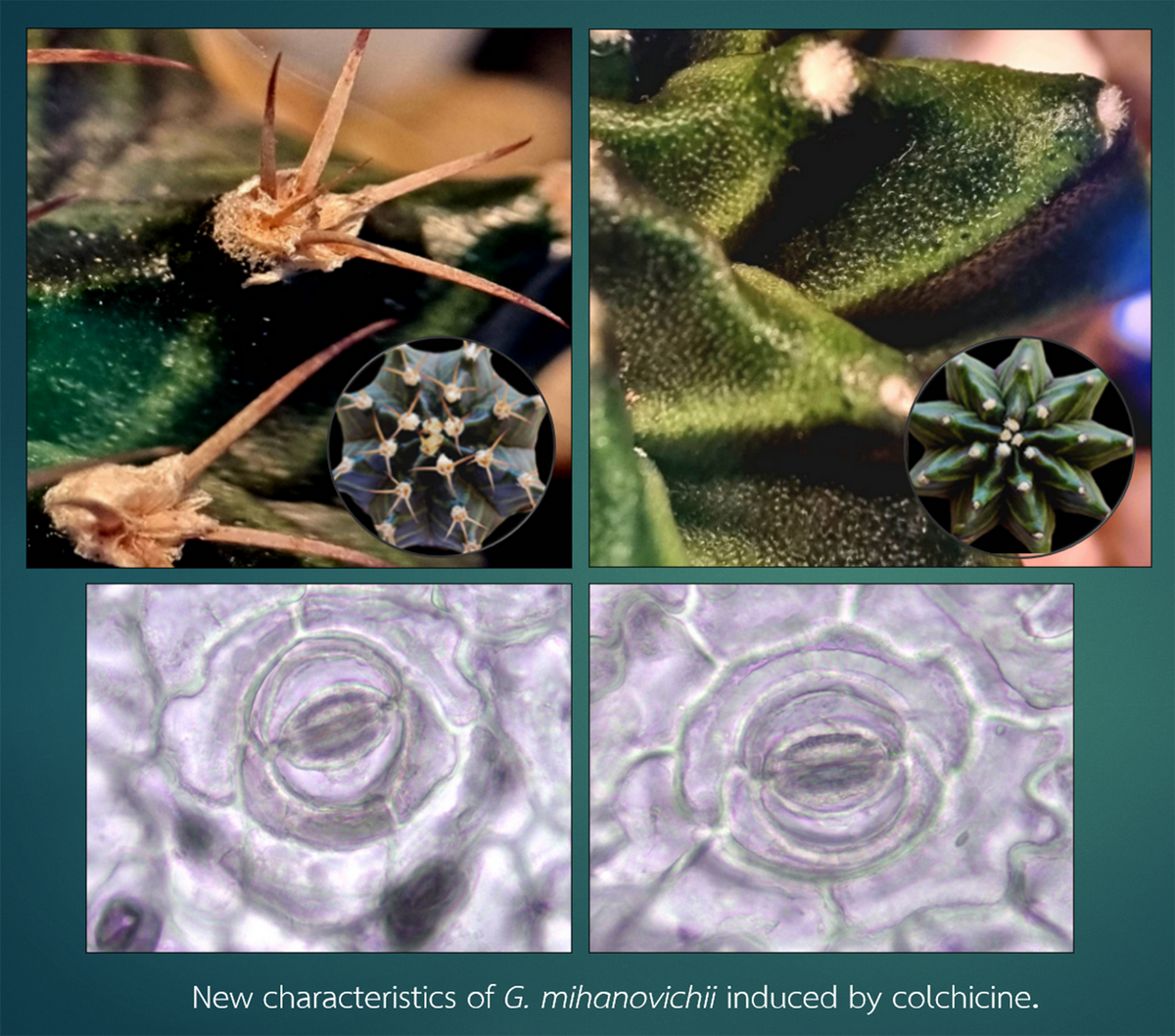Effect of Colchicine on Morphological and Anatomical Traits of Gymnocalycium mihanovichii (Frič & Gürke) Britton & Rose
DOI:
https://doi.org/10.48048/tis.2023.6597Keywords:
Cactus, Colchicine, Stomata, Spineless, Morphological traitAbstract
Cacti are economic ornamental plants whose value varies with market trends. Recently, cacti with new morphologies compared to the original plant have decreased in popularity. Colchicine is a tricyelic alkaloid substance, It is an inhibitor of mitosis thus preventing the formation of microtubuli and the mitotic spindle. This research investigated the effect of colchicine on inducing morphological and anatomical traits in Gymnocalycium mihanovichii using a 2-factor factorial completely randomized design (CRD) The first factor was the duration of the dipped stem at 24 and 48 h, while the second factor was the colchicine concentration at 0.25 and 0.5 %. Results indicated that G. mihanovichii treated with colchicine at different concentrations and dipping durations showed statistically significant differences in plant height, stem diameter, number of spines and root length. G. mihanovichii treated with 0.50 % colchicine for 48 h developed a new morphological trait called spineless cactus. Occurrences of larger sized stomata with lower frequency per unit area were statistically significantly different after treatment with 0.25 % colchicine for 24 h. Maximum length of stomatal guard cells was 50.33 µm.
HIGHLIGHTS
- mihanovichii is the most valuable cactus species, both in the Thai market and trade worldwide and new characteristic would be commercially beneficial and demand high prices in the cactus market because it is rarely found in nature
- mihanovichii can be induced to develop new characteristics using colchicine such as variegated stem color, spineless, cristata and monstrosities. These traits may increase the market value of the cacti both domestically and abroad
- The epidermis of the stem of mihanovichii was observed. Both types of stomata were found distributed in the tissue
GRAPHICAL ABSTRACT
Downloads
Metrics
References
EF Anderson. The cactus family. Timber Press Portland, Oregon, 2001.
R Nyffeler and U Eggli. An up-to-date familial and suprafamilial classification of succulent plants. Bradleya 2010; 28, 125-44.
PJ Stevens. Angiosperem phylogeny website, Available at: http://www.mobot.org/MOBOT/research/APweb, accessed December 2022.
M Arakaki, PA Christin, R Nyffeler, A Lendel, U Eggli, RM Ogburn, E Spriggs, M Moore and EJ Edwards. Contemporaneous and recent radiations of the world’s major succulent plant lineages. Proc. Natl. Acad. Sci. Unit. States Am. 2011; 108, 8379-84.
V Heywood. Conservation and sustainable use of wild species as sources of new ornamentals. International Society for Horticultural Science, Leuven, Belgium, 2014, p. 43-53.
G Barbera, F Carimi and P Inglese. The reflowering of prickly pear (Opuntia ficusindica (L.) Miller): Influence on removal time and cladode load on yield and fruit ripening. J. Am. Soc. Horticultural Sci. 1991; 5, 77-80.
PS Nobel and M Castañeda. Seasonal, light and temperature influences on organ initiation for unrooted cladodes of the prickly pear cactus Opuntia ficusindica. J. Am. Soc. Horticultural Sci. 1994; 123, 47-51.
X Wang, P Felker and A Paterson. Environmental influences on cactus pear fruit yield, quality and cold hardiness and development of hybrids with improved cold hardiness. J. Prof. Assoc. Cactus Dev. 1997; 2, 48-59.
S Boonyang. 2016, Business plan for building a new business SB cactus garden. Master Thesis. Bangkok University, Bangkok, Thailand.
WH Eng and WS Ho. Polyploidization using colchicine in horticultural plants: A review. Sci. Horticulturae 2019; 246, 604-17.
A Manzoor, T Ahmad, MA Bashir, AI Hafiz and C Silvestri. Studies on colchicine induced chromosome doubling for enhancement of quality traits in ornamental plants. Plants 2019;
, 194.
M He, W Gao, Y Gao, Y Liu, X Yang, H Jiao and Y Zhou. Polyploidy induced by colchicine in Dendranthema indicum var. aromaticum, a scented chrysanthemum. Eur. J. Horticultural Sci. 2016; 81, 219-26.
G Liu, Z Li and M Bao. Colchicine-induced chromosome doubling in Platanus acerifolia and its effect on plant morphology. Euphytica 2007; 157, 145-54.
W Termkietpisan. Effect of different colchicine concentration on Llaxtex amount and chahges in centain stomata characyeristics of Hevea brasiliensis muell. Arg. seedlings in vivo. Kasetsart J. 2013; 47, 311-22.
M Tuwo and A Indrianto. Improvement of orchid vanda hybrid (Vanda limbata Blume x Vanda tricolor Lindl. Var. suavis) by colchicines treatment in vitro. Mod. Appl. Sci. 2016; 10, 83.
M Kazemi, B Kaviani and Y Benitez-Alfonso. Anatomical, morphological and physiological change in colchicine-treated protocorm-like bodies of Catasetum pileatum Rchb.f. in vitro. Cogent Biol. 2020; 6, 1840708.
M Sabzehzari, S Hoveidamanesh, M Modarresi and V Mohammadi. Morphological, anatomical, physiological and cytological studies in diploid and tetraploid plants of Plantago psyllium. Plant Cell Tissue Organ Cult. 2019; 139, 131-7.

Downloads
Published
How to Cite
Issue
Section
License
Copyright (c) 2023 Walailak University

This work is licensed under a Creative Commons Attribution-NonCommercial-NoDerivatives 4.0 International License.






